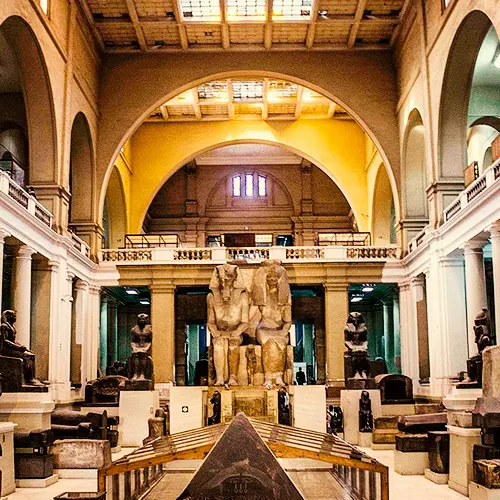
Karnak temple is located on the east bank of the Nile River in Thebes, or Luxor city now. It is considered a complex, not just a temple, because its walls include several temples, such as the Khonsu temple, the Opet temple, and the great temple of Amun Ra.
This complex is considered one of the most important ancient Egyptian temples in Thebes, as it was the center for worshipping the god Amun. So this temple was extremely wealthy, and its priesthood held great political power during ancient Egyptian history.
As most ancient Egyptian temples, Karnak temple was constructed on an east-west axis. As in ancient Egyptian mythology, they thought that this design looking like the sun god’s trajectory through the sky. Also, Karnak temple distinguishes with another north-south axis to link between Karnak complex and Luxor temple through the avenue of rams.
- This complex starts with an avenue of rams. In front of the 1st pylon, there are 20 rams on each side, dating back to King Nectanebo I of the 30th dynasty.
Karnak Complex Elements The design of Karnak Complex is very complicated, as due to its religious importance, many kings from the middle kingdom to the Ptolemaic period added buildings to this complex, making it reach a size, complexity, and diversity.

- Then, the first open court, containing several elements. The column or kiosk of King Taharqa of the 25th dynasty. This is the only remained column from a colonnade that once had 10 columns. On the left, there are 3 shrines built by king Seti II for the triad of Thebes (Amun, Mut, and Khonsu). On the right, there is the Temple of King Ramses III. As well, there is the open museum court containing the white shrine of king Senusret I, the alabaster shrine of king Amenhotep I, and the red shrine of Queen Hatshepsut. These shrines were discovered into the 3rd pylon and rebuilt again.
- The second pylon of king Horemheb of the 18th
- The Great Hypostyle Hall containing 134 columns from the sandstone. This hall was built by King Amenhotep III and completed by kings Seti I and his son Ramses II.
- Then the 3rd pylon of king Amenhotep III, where the 3 shrines in the open museum court had found.
- The Court of Thutmose I, where was existing 2 obelisks standing in front of the 4th pylon. It is thought that this pylon was the main entrance for Karnak temple during king Thutmose I’s period. Unfortunately, one of these two obelisks is lost.
- Another court of King Thutmose I. This court housed 2 obelisks for Queen Hatshepsut. They were made of red granite. Unfortunately, the right obelisk is lost. After the death of Queen Hatshepsut, so King Thutmose III did a mysterious thing. He founded a high wall around those two obelisks. This sparked a lot of arguments among scholars, as they are wondering what the purpose of this wall is.
- The 5th pylon, which also was built by king Thutmose I, but was damaged.
- The 6th pylon was built by king Thutmose III. It is the smallest pylon in this complex. This pylon leads to the Ancestral Room founded by King Thutmose III.
- Then the Holy of Holies of temple.
- Behind it, there is a courtyard housing remains dating back to the middle kingdom. This courtyard contains a hall called (Akh-Mnw), meaning the Feasts Hall. This hall was built by King Thutmose III. As well, there is another room called The Botanical Room, decorated with depictions of plants, animals, and birds, which King Thutmose III brought from Syria to ancient Egypt.
- Now, we will go through the north-south axis that can be accessed between the 3rd and the 4th pylons to reach the 7th pylon of king Thutmose III. In this place in 1902, the French Egyptologist Georges Legrain discovered a cache. This cache contained several bronze statues. In front of the 7th pylon, there were 2 obelisks of king Thutmose III. One of them is transferred to İstanbul, as Muhammad Ali Pasha gave it to King Louis.
- Karnak Complex distinguishes with its sacred lake, where priests purified themselves before performing temple rituals for the god Amun. Besides this lake, you will be able to notice the scarab is considered the biggest scarab in ancient Egypt. This is the scarab of the marriage of King Amenhotep III and his beloved wife Tiye.


- The 8th pylon was built by Queen Hatshepsut, completed by Thutmose III, and restored by Seti I. Then there is a court.
- The 9th and 10th pylons. They date back to king Horemheb of the 18th dynasty. Inside these pylons are the rocks of the temple of the god Aton, as king Horemheb used them to fill his pylons.
- Finally, the temple finished with the avenue of rams leading to Mut temple.









